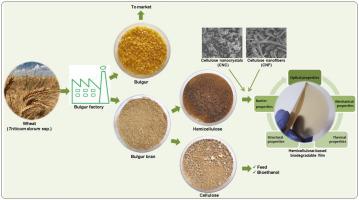Industrial Crops and Products ( IF 5.6 ) Pub Date : 2021-07-24 , DOI: 10.1016/j.indcrop.2021.113847 Didem Sutay Kocabaş 1 , Merve Erkoç Akçelik 1 , Erinç Bahçegül 2 , Hatice Neval Özbek 3

|
Bulgur bran is a lignocellulosic side-stream of bulgur production factories. Separation of bulgur bran into cellulose- and hemicellulose-rich fractions paved the way of utilization of this under-exploited agro-industrial biomass. Although hemicellulose-based biodegradable food packaging films provide significant advantages, their high water solubility and low mechanical strength are obstacles to their commercialization. To overcome these bottlenecks, commercial cellulose nanocrystal (CNC) and cellulose nanofiber (CNF) were incorporated into the hemicellulose matrix. Besides, addition of citric acid (CA) was investigated for its plasticizing effect. To minimize the film water solubility (FWS) statistical optimization by Box-Behnken design (BBD) and response surface methodology (RSM) was employed. The proposed full-quadratic model was found to have high accuracy (R2 = 0.9877) within 95 % confidence interval. The results revealed that 10 % (w/w) CNC- and 10 % (w/w) CNF-incorporated films exhibited 21.3 % reduction in FWS compared to neat films. CNC- and CNF-reinforced films showed a compact structure in SEM analysis. CNC and CNF as fillers in the hemicellulose network markedly improved the tensile strength of the films. Nanocellulose incorporation caused a decrease in water vapor permeability (WVP), light transmittance, total color difference and biodegradability of the films. The properties of nanocellulose-reinforced and neat films were also compared using thermogravimetric analysis (TGA), differential scanning calorimetry (DSC), and Fourier transform infrared spectroscopy (FTIR). Presence of nanocelluloses in the films increased the glass transition temperature (Tg) by around 15 °C as shown by DSC analysis.
中文翻译:

作为生物聚合物来源的碾碎麦麸:水溶性降低的纳米纤维素增强半纤维素基可生物降解薄膜的生产和表征
碾碎麦麸是碾碎碾碎生产工厂的木质纤维素侧流。将小麦麸皮分离成富含纤维素和半纤维素的部分为利用这种未充分利用的农工业生物质铺平了道路。尽管基于半纤维素的可生物降解食品包装膜具有显着优势,但它们的高水溶性和低机械强度是其商业化的障碍。为了克服这些瓶颈,商业纤维素纳米晶体 (CNC) 和纤维素纳米纤维 (CNF) 被加入到半纤维素基质中。此外,研究了添加柠檬酸(CA)的增塑效果。使用 Box-Behnken 设计 (BBD) 和响应面方法 (RSM) 来最小化薄膜水溶性 (FWS) 统计优化。R 2 = 0.9877) 在 95% 置信区间内。结果表明,与纯薄膜相比,掺入 10% (w/w) CNC 和 10% (w/w) CNF 的薄膜的 FWS 减少了 21.3%。CNC 和 CNF 增强薄膜在 SEM 分析中显示出紧凑的结构。CNC和CNF作为半纤维素网络中的填料显着提高了薄膜的拉伸强度。纳米纤维素的掺入导致薄膜的水蒸气渗透率 (WVP)、透光率、总色差和生物降解性降低。还使用热重分析 (TGA)、差示扫描量热法 (DSC) 和傅里叶变换红外光谱 (FTIR) 比较了纳米纤维素增强薄膜和纯薄膜的性能。薄膜中纳米纤维素的存在提高了玻璃化转变温度(T g ) 大约 15 °C,如 DSC 分析所示。











































 京公网安备 11010802027423号
京公网安备 11010802027423号